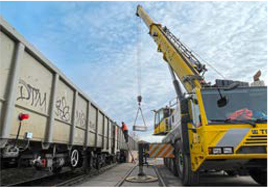Freight wagons fitted with onboard technology that enables them to report faults, loading issues and even derailments could be a regular sight on the UK rail network in the next few years.
Network Rail is sponsoring the project as a ‘proof of concept’ exercise to examine whether ‘intelligent’ wagons could help to improve preventative maintenance and the safety of freight trains, especially those carrying dangerous goods such as oil and chemicals.
A set of six modified JNA bogie box wagons (Ealnos 81 70 5500 001/002/009/010/012/048), owned by leasing company Ermewa and leased to Tarmac, has been tested at Barrow Hill Roundhouse to prove a concept developed by a group of UK companies led by Railfreight Consulting.
The wagons are fitted with an array of sensors on the bogies, axle ends and body, providing constant updates to a data hub. Power for the system is supplied from a module on the locomotive via a three-wire jumper cable, eliminating the need for additional batteries on each wagon.
The project aims to deliver a more cost-effective solution for adding a ‘digital spine’ to freight trains than the Digital Auto Coupler (DAC) concept currently being developed in mainland Europe.
DAC involves the replacement of conventional couplings and buffers with a Scharfenberg-style auto- coupler carrying all electrical and air connections through a train.
“We don’t need DAC in the UK,” Railfreight Consulting Managing Director Ralph Goldney told RAIL.
“We can do a better job with a digital connection and power line to provide fault monitoring and reporting in real time. Our power line is simpler, cheaper and weighs less.”
















Login to comment
Comments
Mike Lipscomb - 16/02/2024 11:21
Surely the main purpose of the DAC is to prevent staff having to go between vehicles to lift the coupling chain on to the drawhook and connect the brake hoses. These are time-consuming, strenuous and potentially hazardous activities. The ability to provide a data and power spine for on-vehicle RCM systems is a secondary benefit.